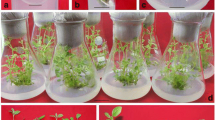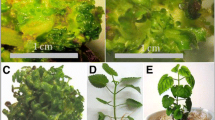Abstract
The effect of thidiazuron (TDZ) has been investigated in shoot multiplication for a simple, efficient, rapid, and commercially applicable regeneration protocol of an important medicinal plant, Vitex trifolia. Multiple shoots were induced in nodal explants obtained from a mature tree on Murashige and Skoog (MS) medium supplemented with TDZ in various concentrations (0.5, 1.0, 2.5, 5.0, 7.5, or 10.0 μM). Prolonged exposure of the culture to TDZ had an adverse affect. To avoid this, the cultures were transferred to TDZ-free MS medium or MS medium fortified with various concentrations of 6-benzyladenine (BA) alone or in combination with α-naphthalene acetic acid (NAA) to enhance multiplication, proliferation, and elongation of induced shoots. Optimum shoot multiplication and elongation was achieved when TDZ-exposed explants were repeatedly subcultured on MS media containing a combination of 1.0 μM BA and 0.5 μM NAA. The highest shoot regeneration frequency (90 %) and maximum number (22.3 ± 0.2) of shoots per explant with shoot length of (5.2 ± 0.2 cm) was recorded on MS medium fortified with 5.0 μM TDZ. In vitro rooting of isolated shoots was achieved best in half-strength MS medium containing 0.5 μM NAA. Properly rooted plantlets were successfully hardened off and acclimatized in thermocol cups containing sterile Soilrite. These plantlets were then transferred to pots containing different potting substrate; percentage survival of the plantlets was highest in vermiculite/garden soil mixture (1:1) and successfully transfer to greenhouse under sunlight.




Similar content being viewed by others
References
Anonymous. (2003). The wealth of India—raw materials, Vol. X (p. 525). New Delhi: CSIR.
Kirtikar, K. R., & Basu, B. D. (1991). Indian medicinal plants (pp. 1935–1944). Allahabad: Lalit Mohan Basu.
Varier, P. S. (2003). Indian medicinal plants (pp. 387–395). Hyderabad: Orient Longman.
Pullaiah, T., & Naidu, K. C. (2003). Antidiabetic plants in India and herbal bases antibiotic research (pp. 314–315). New Delhi: Regency Publication.
Kannathasan, K., Senthilkumar, A., Chandrasekaran, M., & Venkatesalu, V. (2007). Parasitology Research, 101, 1721–1723.
Woradulayapinij, W., Soonthornchareonnon, N., & Wiwat, C. (2005). Journal of Ethnopharmacology, 101(1-3), 84–89.
Li, W. X., Cui, C. B., Cai, B., Wang, H. Y., & Yao, X. S. (2005). Journal of Asian Natural Products Research, 7, 615–626.
Hernandez, M. M., Heraso, C., Villareal, M. L., Vargas-Arispuro, I., & Aranda, E. (1999). Journal of Ethnopharmacology, 67, 37–44.
Hossain, M. M., Paul, N., Sohrab, M. H., Rahman, E., & Rashid, M. A. (2001). Fitoterapia, 72, 695–697.
Ikram, M., Khattak, S. G., & Gilani, S. N. (1987). Journal of Ethnopharmacology, 19, 185–192.
Chadha, Y. R. (1976). The wealth of india, raw materials. Vol. 10. Publication and Information Directorate. New Delhi: CSIR.
Faisal, M., Siddique, I., & Anis, M. (2006). Annals of Applied Biology, 148, 1–6.
Ahmad, N., & Anis, M. (2007). Agroforestry System, 71, 195–200.
Murashige, T., & Skoog, F. (1962). Physiologia Plantarum, 15, 473–497.
Mok, M. C., Mok, D. W. S., Armstrong, D. J., Shudo, K., Isogai, Y., & Okamoto, T. (1982). Phytochemistry, 21, 1509–1511.
Wang, S. Y., Steffens, G. L., & Faust, M. (1986). Phytochemistry, 25, 311–317.
Faisal, M., Ahmad, N., & Anis, M. (2005). Plant Cell Tissue Organ Culture, 80, 187–190.
Husain, M. K., Anis, M., & Shahzad, A. (2007). In Vitro Cellular Developmental Biology of Plants, 43, 59–64.
Huetteman, C. A., & Preece, J. E. (1993). Plant Cell Tissue Organ Culture, 33, 105–119.
Thomas, J. C., & Katterman, F. R. (1986). Plant Physiology, 81, 681–683.
Capelle, S. C., Mok, D. W. S., Kirchner, S. C., & Mok, M. C. (1983). Plant Physiology, 73, 796–802.
Murch, S. J., & Saxena, P. K. (2001). Plant Growth Regulator, 35, 269–275.
Siril, E. A., & Dhar, U. (1997). Plant Cell Reports, 16, 637–640.
Carman, J. G., Jefferson, N. E., & Cambell, W. F. (1987). Plant Cell Tissue Organ Culture, 10, 115–128.
Doctrinal, M., Sangwan, R. S., & Sangwan-Norreel, B. S. (1989). Plant Cell Tissue Organ Culture, 17, 1–12.
Arora, K., Sharma, M., Srivastava, J., Ranade, S. A., & Sharma, A. K. (2010). Agroforestry Systems, 78, 53–63.
Jahan, A. A., & Anis, M. (2009). Acta Phyiologiae Plantarum, 31, 133–138.
Hiregoudar, L. V., Murthy, H. N., Bhat, J. G., Nayeem, A., Hema, B. P., Hahn, E. J., & Paek, K. Y. (2006). Biologia Plantarum, 50(2), 291–294.
Parveen, S., & Shahzad, A. (2010). Physiology and Molecular Biology of Plants, 16(2), 201–206.
Kim, M. K., Sommer, H. E., Bongarten, B. C., & Markle, S. A. (1997). Plant Cell Reports, 16, 536–540.
Tiwari, V., Tiwari, K. N., & Singh, B. D. (2001). Plant Cell Tissue Organ Culture, 66, 9–16.
Ahmad, N., & Anis, M. (2005). Turkish Journal of Botany, 29, 237–240.
Ahmad, N., Srivastava, R., & Anis, M. (2006). Propagation of Ornamental Plants, 6(3), 109–113.
Fatima, N., Ahmad, N., & Anis, M. (2011). Plant Physiology and Biochemistry, 49, 1465–1471.
Acknowledgments
Md. Rafique Ahmed is thankful to the University Grants Commission (UGC), Govt. of India, New Delhi for its award of Junior Research Fellow (F1-17.1/2011/MANF-MUS-MAN-581) (SA-III/manfugc). Research support provided by the Department of Science and Technology (DST) in the form of DST-FIST (2011-16) and UGC in the form of UGC-SAP; DRS-I Programme is duly acknowledged.
Author information
Authors and Affiliations
Corresponding author
Rights and permissions
About this article
Cite this article
Ahmed, M.R., Anis, M. Role of TDZ in the Quick Regeneration of Multiple Shoots from Nodal Explant of Vitex trifolia L.—an Important Medicinal Plant. Appl Biochem Biotechnol 168, 957–966 (2012). https://doi.org/10.1007/s12010-012-9799-0
Received:
Accepted:
Published:
Issue Date:
DOI: https://doi.org/10.1007/s12010-012-9799-0




